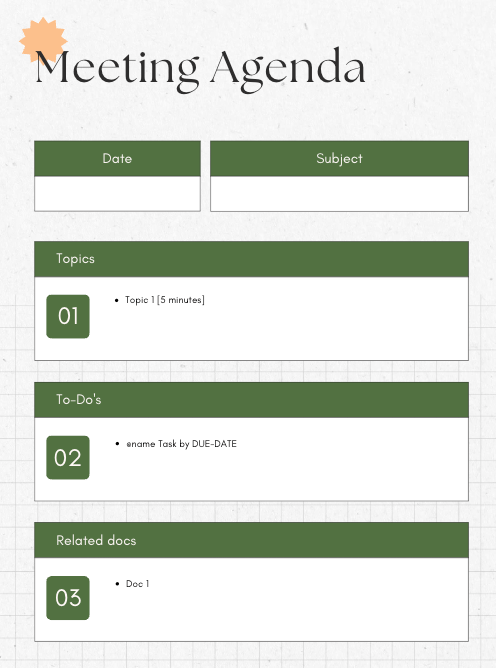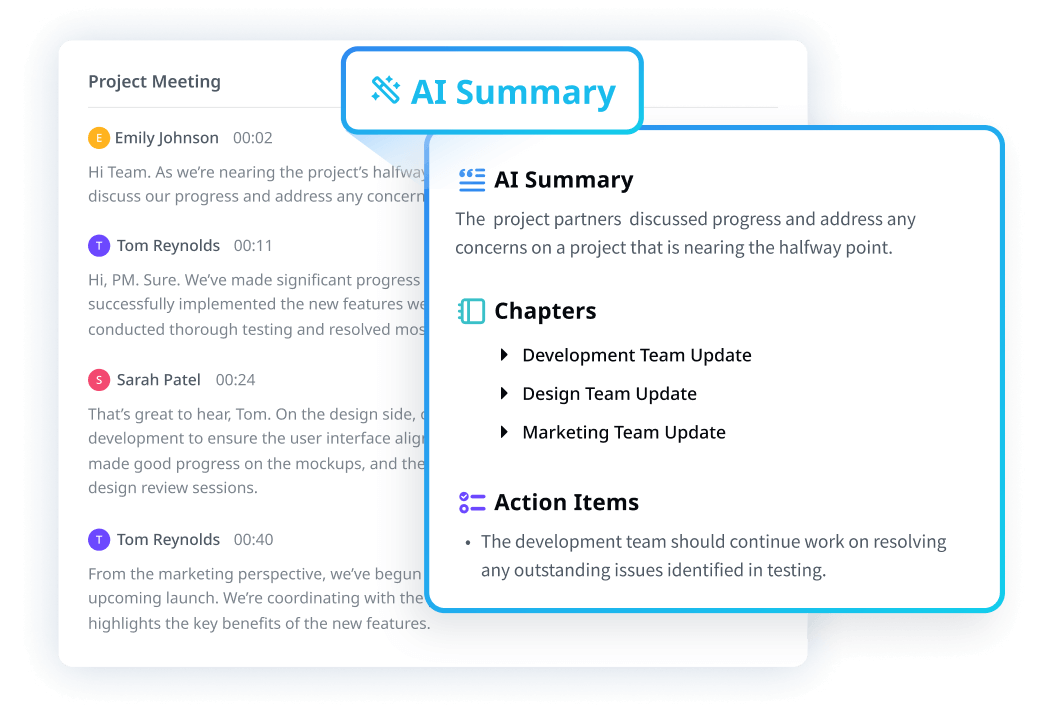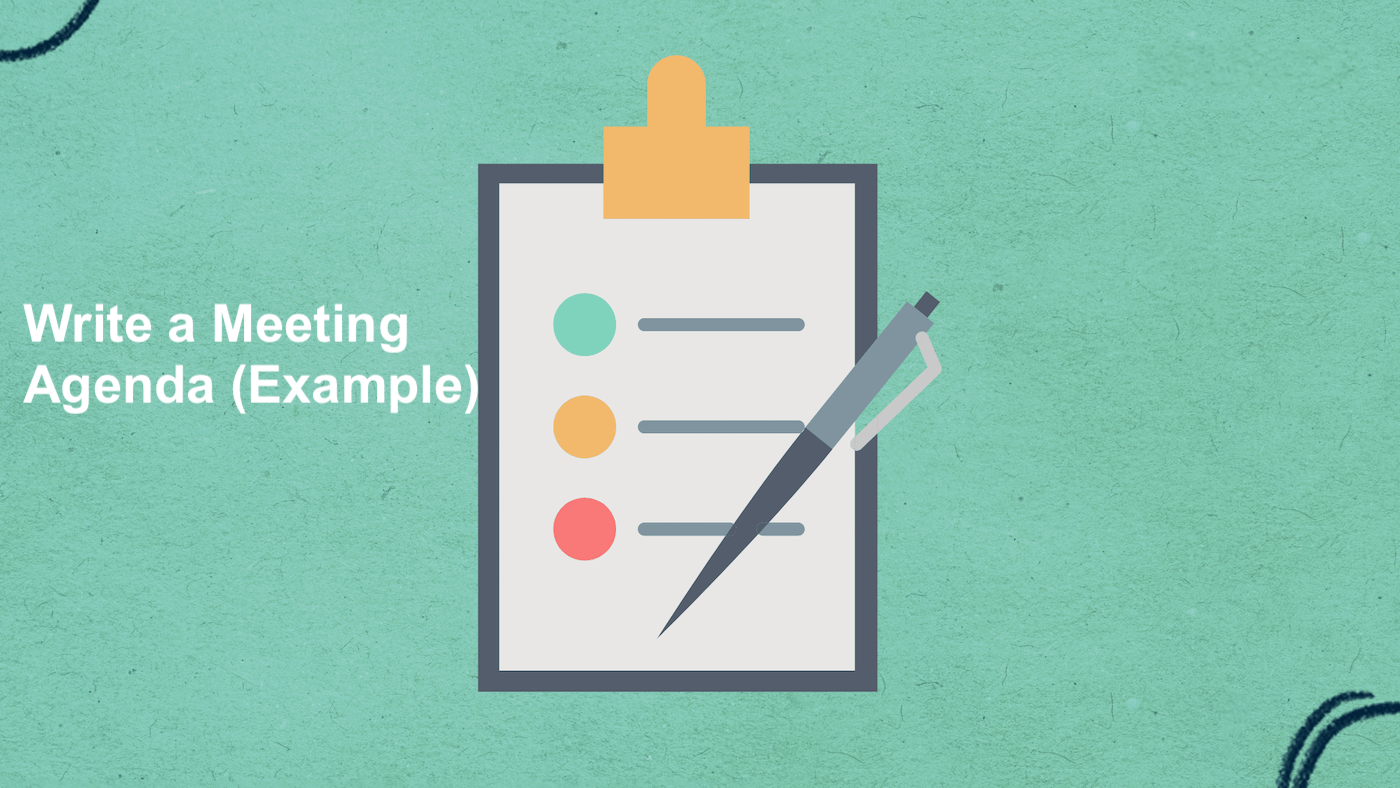Have you ever attended those freestyle meetings where you had no clue about what will be discussed? Such meetings can be frustrating and a waste of time because, without an agenda, the discussions can go off-topic, causing the meeting to run longer than necessary. Also, participants may leave the session feeling that important topics were not covered.
Therefore, knowing how to write a meeting agenda is crucial for a successful meeting, as the agenda encourages participants to come prepared and keeps the meeting on track.
One appalling fact is that even though meetings with clear agendas decrease the meeting time by up to 80%, only 37% of meetings in the United States use agendas.
Explore this article to get valuable tips on writing an agenda for your next meeting and we’ve included meeting agenda templates to get you started right away!
Why prepare an agenda before meetings
If we have a clear agenda in advance and we are fully present and fully contributing, the meetings do go much faster. - Ariana Huffington, co-founder of Huffington Post
A meeting agenda is an organized document that covers the main topics and activities of a meeting. It serves as a roadmap to ensure that all the essential topics are covered during a team meeting and helps to keep the meeting focused and on track.
A well-crafted staff meeting agenda helps you to:
An agenda makes sure all important topics are covered and serves as a blueprint for the meeting. By distributing it before the meeting commences, all participants will be on the same page. Also, having a clearly defined purpose keeps the discussion focused and to the point.
A clearly defined agenda increases accountability among all the participants. It is because each team member gets the time to check related materials and prepare their talking points before the meeting. It gives them sufficient time to come up with ideas, questions, and considerations.
The meeting agenda allocates appropriate time frames for each agenda item, which helps participants prioritize discussion points and focus on the most critical issues. This, in turn, ensures better time management and productivity.
What should be included in a meeting agenda?
Here are some factors that you need to consider while preparing an agenda:
Meeting objective: Write the title and goal of the meeting to help the participant know what this meeting is about at a glance. Keeping it short and clear ensures that everyone knows the purpose of the meeting.
Meeting’s date, time, and location: You should clearly state when the meeting is and what the duration is. It enables the participants to plan their schedules accordingly. Also, inform the attendees of the meeting's location and whether it will be held virtually or in person.
Participants: List all the people who will be attending the meeting. For the meeting to be successful, invite only the people who will contribute to the discussion and the decision-making process.
Supporting documents (if any): These documents can help provide context and background information to the participants, so they review the materials in advance and come to the meeting fully prepared.
Agenda items: These are the major components of a meeting agenda. The items listed serve as specific points that determine the order and the flow of the discussion. It’s essential to clearly and concisely list all the discussion topics to ensure the participants understand the meeting's focus.
Timeframe: To ensure that your team stays on schedule and smoothly transitions between topics, allocating ample time for each agenda item is vital. One effective way to do this is by estimating the time required for each item and adding a few extra minutes as a buffer. It will enable you to wrap up discussions promptly and move on to the next item without delays.
Action Items: The agenda should have a designated section for attendees to record action items and key takeaways during the meeting. It helps structure and consolidate the discussion outcomes and enables attendees to understand the required next steps clearly. The action items can be anticipated when you prepare the meeting agenda and can be changed during or after the meeting.

Effortlessly create meeting minutes
With Notta, you can easily generate meeting minutes, turning spoken content into written records with 98.86% accuracy.
How to write an impactful meeting agenda
Preparing a meeting agenda is not a daunting task once you understand the tricks. Follow the steps below, and you will know how to make an effective agenda for a meeting quickly.
Step 1: Establish a clear focus
To create the agenda for the meeting, define the goal of the meeting and identify your objectives. By establishing a clear focus and purpose, attendees will be better prepared and able to contribute meaningfully to the discussion.
Your goals should be achievable and specific, and describe what you hope to achieve during the meeting. Here is an example:
Step 2: Categorize and prioritize the agenda items
For a productive meeting, it is essential to structure the meeting agenda properly by grouping similar items and arranging them in a way that they build off one another can help the meeting flow smoothly. Additionally, this will keep the team focused and engaged throughout the session.
An agenda typically includes three categories of items:

For team meetings, don’t forget to designate a topic leader for each agenda item, which allows for more efficient use of time, as each team member will be responsible for preparing for their assigned topic in advance.
To choose a topic leader, simply identify who in the group is most knowledgeable about or interested in the subject matter. Then, provide them with an overview of what you would like covered during the meeting.
Step 3: Set a time limit for each item
Admit it, we have prolonged meetings, and participants tend to get frustrated when the meeting lasts longer than expected. That’s why you need to give an estimated duration of the meeting and keep it within the time frame, and the best way to do so is to give an allotted time for each agenda topic.
Here are some tips for setting time limits:
Have an accurate estimate of the time required for each task; be realistic as overly ambitious time limits can lead to burnout and frustration.
Identify the most important tasks and allocate more time for them.
Regularly review your time limits and adjust them as needed. This will help you to continually improve your time management skills.
Also, if someone other than the host will be facilitating a particular section, be sure to include that information as well. This approach will help keep the discussion on track and ensure all topics are covered within the allocated time frame.
Step 4: Include relevant documents
Assessing the required documents supporting the meeting and creating a detailed list is crucial. The documents may include:
Including this list in the agenda helps keep everyone informed, so they bring the required documents for the meeting.
Also, if there is any pre-reading material, such as a presentation deck, the link should be included in the agenda. It will ensure that everyone gets the context of the meeting and crucial time is saved.
Step 5: Ask for input from your team
Remember that the wisdom of the team is often greater than that of one person. By asking team members if they think anything needs to be added to the agenda, you can identify missing topics and any areas of confusion or disagreement. Asking for input also gives people a chance to think about any questions they might have and makes sure the agenda truly reflects the needs of the team.
This behavior shows that you value everyone's input and are committed to making the meeting as productive and efficient as possible.
Finally, don’t forget to review the meeting agenda at the end of the meeting and discuss what could be improved. Questions like “Do we include the necessary agenda topics?” or “Is the meeting’s objective clear?” This will help you build a more effective discussion next time.
Meeting agenda example
Now you know how to create a meeting agenda. Below, we’ve included a sample meeting agenda that you could use for inspiration, taking a quarterly planning meeting as an example:
[Basic Info]
Meeting Title:
Date:
Time and location:
Meeting goal:
Members:
[Attached Materials]
Quarterly sales report
Review Last Quarter
Check-in on the overall performance, wins, and lessons learned from the last quarter.
Key metrics
Successes and wins
Learnings
Goals
Outline the main company objectives and determine the end goals of this quarter.
Quarter Plan
Obstacles and Considerations
Discuss the potential factors happening throughout the quarter that might act as obstacles.
Next Steps
What do we plan to accomplish until the next meeting?
Capture every detail with AI meeting notes
Notta offers the most integrated AI meeting notes, summaries, and action items so nothing gets missed.
9 free meeting agenda templates
Creating an agenda for a meeting from scratch can be time-consuming and challenging. So, the Notta team of meeting professionals provides templates for different types of meetings. You can apply and customize the pre-existing templates accordingly for your needs.
Here are the most popular meeting templates:
1. Weekly team meeting agenda template
This template helps you evaluate your team's progress over the past week, plan for upcoming tasks or projects, and encourage collaboration and idea sharing among team members.
Team Check-in [5 mins]
Some casual talking or new hire presentation.
Review Metrics [15 mins]
Share updates and metrics on important projects in the past week.
Priorities [10 mins]
What will every team member focus on in the new week?
Roadblocks [10 mins]
What are the biggest blockers that hinder us from achieving our goals?
What adjustments do we need to make?
Next Steps
Assign action items to the specific member with an estimated completion date.
2. One-on-one meeting agenda
Regular 1:1 meetings between managers and direct reports are crucial for making employees feel valued and supported at work.
Check-in
Start with open-ended questions.
Follow-ups from last week
Follow up on the working progress since the previous week’s 1:1. Dive a bit deeper into a work-related discussion.
Roadblocks
This is where employees share any blockers and get assistance.
Next Steps
Discuss the priority work for the new week ahead and the goals.
3. OKR planning meeting agenda
Facilitate OKR Planning sessions and keep your team aligned toward your organization’s goals. Kickstart your meeting with this OKR planning template.
Company Vision
Review the company vision and goals to make sure your team OKR is in line with the bigger picture.
Brainstorming
Brainstorm with your team what areas you should focus on for the next period.
Set Objectives and KRs
Come up with objectives and actionable points to achieve them.
Objective 1- KRs
Objective 2- KRs
Final OKR Set
Take time to discuss the final OKR set.
Action Items
List a detailed set of tasks and assign each to a responsible person.
4. Brainstorming meeting agenda template
Facilitate idea generation and ensure the participation of all team members with this agenda template.
Objectives [5 minutes]
Keep everyone informed of the objectives of this brainstorming session.
Ground Rules [5 minutes]
Set up the ground rules during the discussion.
Brainstorming Ideas [20 minutes]
Set time for everyone to think and share their ideas. Write down all the ideas.
Discussion and Vote on Ideas [10 minutes]
Improve on the Ideas [10 minutes]
Look at the most-voted ideas and see how to improve them or ways to put them into practice.
Action Items
5. First one-on-one meeting with new employee agenda
Establish a positive relationship, set expectations, and make it easy for the new employee to communicate with the help of this template.
Welcome onboarding
Show your welcome to the new employee and break down the barriers a little.
Tell me more about yourself
Roles and expectations
Briefly introduce the main job duties, and learn the employee’s expectations.
What are your expectations for this role?
What kind of projects are you most excited to work on?
How would you like to receive feedback - publicly or privately?
Career development
Learn about the employee’s career goals and possibly give your opinion.
Let’s talk about what I expect from you as a professional
What would you like to accomplish in this company?
What are your 1-year, 3-year, and 5-year career goals?
Anything else to know
Action Items
What came out of this meeting and set the next steps
6. Quarterly performance review template
Use this template to outline the key performance indicators (KPIs) and goals that employees are expected to meet over a three-month period.
Employee name:
Department:
Review period:
Date of review:
Overall Assessment
Review an employee’s overall performance for the quarter from perspectives like achievements, team collaboration, work ethics, etc.
Performance against Goals
Review if the employees are meeting the goals that were set forth; highlight wins and give positive feedback.
Areas for Growth
Help employees identify what could have been done better and any growth opportunities.
Future Goals & Expectations
List some goals for the quarter to come.
Additional Comments
Allow employees to share any concerns or questions they may have and have a friendly discussion.
7. Daily Standup meeting agenda template
Daily standup, as an agile method, is commonly used to keep the project running smoothly by having a 10-minute gathering every day, usually in the morning.
Project Updates
Give each team member time to answer the below questions:
Next Steps
Assign action items to the specific member with an estimated completion date.
8. All-hands meeting agenda template
All-hands meetings are a chance for the entire organization, leaders and employees, to get together and hear about what's happening. They're also an opportunity for employees to ask questions and give feedback.
Opening
Some icebreakers to help people loosen up.
Company Vision
Reiterate the company vision and retro on goals to keep everyone aligned.
Business Update
Bring in high-level metrics like revenue increase to let all employees know where we are going. Celebrate wins with all hands.
Announcements
Share news on promotions, new hires, fundraising, work anniversaries, and others that should be known to all.
Team Spotlight
Invite a leader from a different department (most often the team that has made significant progress) each time to share the updates and experience.
Employee Q&A
ASK ME ANYTHING session. The CEO or leadership team will take questions from employees and give answers.
9. Sprint planning meeting agenda
Kick off the sprint directly by defining the backlog items that need to be considered and tackled in the next sprint.
The Last Retrospective
Sprint Goals
What is the team committed to in this sprint?
Product Backlog Items
Which product backlog items are to be accomplished this sprint?
Tasks
Divide product backlog items into smaller deliverables
Action items
Build a great agenda for your next meeting
In conclusion, writing a meeting agenda is an important step in ensuring that your meetings are productive and efficient.
By taking the time to create a clear and concise agenda, you can set expectations, keep everyone on track, and make the most of the time you have together. Remember to include all necessary information, prioritize topics, and provide context where needed.
By following these steps and templates listed in this post, you’ll be sure to create one by yourself.


